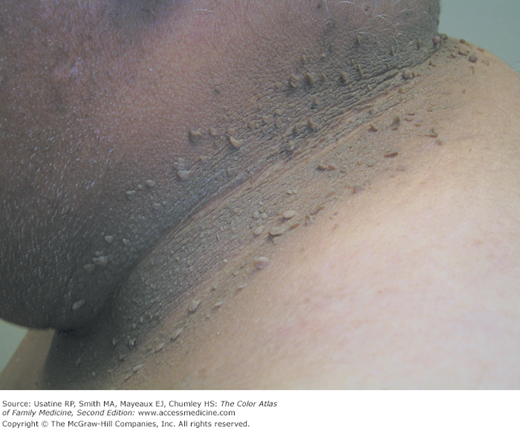Patient Story
A 55-year-old man requests removal of multiple skin tags around his neck. He is overweight and has diabetes and acanthosis nigricans. Although some of his skin tags occasionally get caught on his clothing, he just doesn’t like the way they look. The patient chose to have many of them removed by the snip excision method.
Introduction
Epidemiology
- In an unselected population study, skin tags were found in 46% of patients, particularly in patients who were obese.1
- Skin tags increase in frequency through the fifth decade of life so that as many as 59% of individuals have them by the time they are 70 years old; however, the increase slows after age 50 years.1
Etiology and Pathophysiology
- Three types of skin tags are described:1
- Small, furrowed papules of approximately 1 to 2 mm in width and height, located mostly on the neck and the axillae (Figure 157-1).
- Single or multiple filiform lesions of approximately 2 mm in width and 5 mm in length occurring elsewhere on the body (Figure 157-2).
- Large, pedunculated tumor or nevoid, bag-like, soft fibromas that occur on the lower part of the trunk (Figure 157-3).
- Etiology is unknown, but it is theorized that skin tags occur in localized areas with a paucity of elastic tissue resulting in sessile or atrophic lesions. In addition, hormone imbalances appear to facilitate their development (e.g., high levels of estrogen and progesterone seen during pregnancy) and other factors including epidermal growth factor, tissue growth factor-α, and infection (e.g., human papillomavirus) have been implicated as cofactors.
- Acrochordons also appear to be associated with impaired carbohydrate metabolism and diabetes mellitus (Figure 157-1).2
- Pedunculated lesions may become twisted, infarcted, and fall off spontaneously.
- Very rarely neoplasms are found at the base of skin tags. In a study of consecutive cutaneous pathology reports, 5 of 1335 clinically diagnosed fibroepithelial polyp specimens were malignant (i.e., 4 were basal cell carcinomas and 1 was squamous cell carcinoma in situ).3 There is selection bias in this study because most skin tags are not sent to the pathologist.

Full access? Get Clinical Tree





